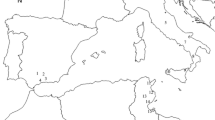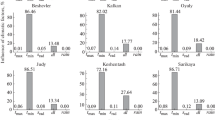Abstract
This study examined the impact of weather-related variables on flowering phenology in the Cornicabra olive tree and constructed models based on linear and Poisson regression to forecast the onset and length of the pre-flowering and flowering phenophases. Spain is the world’s leading olive oil producer, and the Cornicabra variety is the second largest Spanish variety in terms of surface area. However, there has been little phenological research into this variety. Phenological observations were made over a 5-year period (2009–2013) at four sampling sites in the province of Toledo (central Spain). Results showed that the onset of the pre-flowering phase is governed largely by temperature, which displayed a positive correlation with the temperature in the start of dormancy (November) and a negative correlation during the months prior to budburst (January, February and March). A similar relationship was recorded for the onset of flowering. Other weather-related variables, including solar radiation and rainfall, also influenced the succession of olive flowering phenophases. Linear models proved the most suitable for forecasting the onset and length of the pre-flowering period and the onset of flowering. The onset and length of pre-flowering can be predicted up to 1 or 2 months prior to budburst, whilst the onset of flowering can be forecast up to 3 months beforehand. By contrast, a nonlinear model using Poisson regression was best suited to predict the length of the flowering period.



Similar content being viewed by others
References
Aguilera F, Ruiz L (2009) Study of the floral phenology of Olea europaea L. in Jaén province (SE Spain) and its relation with pollen emission. Aerobiologia 25(4):217–225
Aguilera F, Fornaciari M, Ruiz-Valenzuela L, Galán C, Msallem M, Ben Dhiab A, de la Díaz Guardia C, Trigo MM, Bonofiglio T, Orlandi F (2014) Phenological models to predict the main flowering phases of olive (Olea europaea L.) along a latitudinal and longitudinal gradient across the Mediterranean region. Int J Biometeorol. doi:10.1007/s00484-014-0876-7
Akaike H (1974) A new look at the statistical model identification. IEEE Trans Autom Control 19(6):716–723
Alba F, de la Díaz Guardia C (1998) The effect of air temperature on the starting dates of the Ulmus, Platanus and Olea pollen seasons in the SE Iberian Peninsula. Aerobiologia 14:191–194
Alcalá AR, Barranco D (1992) Prediction of flowering time in olive for the Córdoba olive collection. Hortic Sci 27(11):1205–1207
Atwell BJ, Kriedemann PE, Turnbull CGN (1999) Plants in action: adaptation in nature, performance in cultivation. Macmillan Education AU, Australia
Ayerza R, Sibbett GS (2001) Thermal adaptability of olive (Olea europaea L.) to the Arid Chaco of Argentina. Agric Ecosyst Environ 84:277–285
Badr SA, Hartmann HT, Martin GC (1970) Endogenous gibberellins and inhibitors in relation to flower induction and inflorescence development in the olive. Plant Physiol 46:674–679
Baktir I, Ulger S, Kaynak L, Himelrick DG (2004) Relationship of seasonal changes in endogenous plant hormones and alternate bearing of olive trees. Hortic Sci 39(5):987–990
Barranco D, Rallo L (2000) Olive cultivars in Spain. Hortic Technol 10:107–110
Barranco D, Fernández-Escobar R, Rallo L (2008) El cultivo del olivo, 6th edn. Junta de Andalucía y Ediciones Mundi-Prensa, Madrid, España
Bonofiglio T, Orlandi F, Sgromo C, Romano B, Fornaciari M (2008) Influence of temperature and rainfall on timing of olive (Olea europaea) flowering in southern Italy. New Zeal J Crop Hortic 36:59–69
Bonofiglio T, Orlandi F, Ruga L, Romano B, Fornaciari M (2013) Climate change impact on the olive pollen season in Mediterranean areas of Italy: air quality in late spring from an allergenic point of view. Environ Monit Assess 185:877–890
Cameron AC, Trivedi PK (2013) Regression analysis of count data, 2nd edn. Cambridge University Press, New York, USA
Cesaraccio C, Spano D, Snyder RL, Duce P (2004) Chilling and forcing model to predict bud-burst of crop and forest species. Agric Meteorol 126:1–13
Chmielewski FM (2003) Phenology and agriculture. In: Schwartz MD (ed) Phenology: an integrative environmental science. Kluwer Academic Publ, Dordrecht, Netherlands, pp 505–522
Chuine I, Cour P, Rousseau DD (1998) Fitting models predicting dates of flowering of temperate-zone trees using simulated annealing. Plant Cell Environ 21:455–466
Chuine I, Cour P, Rousseau DD (1999) Selecting models to predict the timing of flowering of temperate trees: implications for tree phenology modelling. Plant Cell Environ 22:1–13
Chuine I, Cambon G, Comtois P (2000) Scaling phenology from the local to the regional level: advances from species-specific phenological models. Glob Chang Biol 6:943–952
Chung U, Mack L, Yun JI, Kim SH (2011) Predicting the timing of cherry blossoms in Washington, DC and Mid-Atlantic States in response to Climate Change. PLos One 6(11):e27439. doi:10.1371/journal.pone.0027439
Civantos M (1998) Sanidad del olivar. Vida rural 40:50–52
Connor DJ, Fereres E (2005) The physiology of adaptation and yield expression in olive. Hortic Rev 31:155–229
Cornelius C, Petermeier H, Estrella N, Menzel A (2011) A comparison of methods to estimate seasonal phenological development from BBCH scale recording. Int J Biometeorol 55:867–877
Crepinsek Z, Kajfez-Bogataj L, Bergant K (2006) Modelling of weather variability effect on fitophenology. Ecol Model 194:256–265
De la Rosa R, Rallo L, Rapoport HF (2000) Olive floral bud growth and starch content during winter rest and spring budbreak. Hortic Sci 35(7):1223–1227
De Melo-Abreu JP, Barranco D, Cordiro AM, Tous J, Rogado BM, Villalobos FJ (2004) Modelling olive flowering date using chilling for dormancy release and thermal time. Agric Meteorol 125:117–127
Delgado A, Benlloch M, Fernández-Escobar R (1994) Mobilization of boron in olive trees during flowering and fruit development. Hortic Sci 29(6):616–618
Denney JO, McEachern GR, Griffiths JF (1985) Modeling the thermal adaptability of the olive (Olea europaea L.) in Texas. Agric Meteorol 35:309–327
Dessens J, Bücher A (1995) Changes in minimum and maximum temperatures at the Pic du Midi in relation with humidity and cloudiness, 1882–1984. Atmos Res 37:147–162
Fernández-Escobar R, Moreno R, Sánchez-Zamora MA (2004) Nitrogen dynamics in the olive bearing shoot. Hortic Sci 39(6):1406–1411
Fornaciari M, Pieroni L, Ciuchi P, Romano B (1998) A regression model for the start of the pollen season in Olea europaea. Granada 37:110–113
Fornaciari M, Galán C, Mediavilla A, Domínguez E, Romano B (2000) Aeropalynological and phenological study in two different Mediterranean olive areas: Cordoba (Spain) and Perugia (Italy). Plant Biosyst 134(2):199–204
Galán C, Cariñanos P, García-Mozo H, Alcazar P, Dominguez-Vilches E (2001a) Model for forecasting Olea europaea L. airborne pollen in South-West Andalusia, Spain. Int J Biometeorol 45:59–63
Galán C, García-Mozo H, Cariñanos P, Alcázar P, Domínguez-Vilches E (2001b) The role of temperature in the onset of the Olea europaea L. pollen season in southwestern Spain. Int J Biometeorol 45:8–12
García-Mozo H (2011) The use of aerobiological data on agronomical studies. Ann Agric Environ Med 18:159–164
García-Mozo H, Pérez-Badia R, Galán C (2008) Aerobiological and meteorological factors’ influence on olive (Olea europaea L.) crop yield in Castilla-La Mancha (Central Spain). Aerobiologia 24:13–18
García-Mozo H, Orlandi F, Galán C, Fornaciari M, Romano B, Ruiz L, Diaz de la Guardia C, Trigo MM, Chuine I (2009) Olive flowering phenology variation between different cultivars in Spain and Italy: modeling analysis. Theor Appl Climatol 95:385–395
García-Mozo H, Mestre A, Galán C (2010) Phenological trends in southern Spain: a response to climate change. Agric Meteorol 150:575–580
Gucci R, Cantini C (2000) Pruning and training systems for modern olive growing. Csiro Publishing, Collingwood VIC, Australia
Guerrero A (2002) Nueva olivicultura, 5th edn. Ediciones Mundi-Prensa, Madrid, Spain
Hardin JW, Hilbe JM (2007) Generalized linear models and extensions, 2nd edn. Stata Press, Texas
Hartmann HT, Fadl MS, Hackett WP (1967) Initiation of flowering and changes in edogenous inhibitors and promoters in olive buds as a result of chilling. Physiol Plant 20(3):746–759
INM Instituto Nacional de Meteorología (2008) Guía resumida del clima en España 1971–2000. Ministerio de Medio Ambiente, Madrid, Spain
Kramer K, Friend A, Leinonen I (1996) Modelling comparison to evaluate the importance of phenology and spring frost damage for the effects of climate change on growth of mixed temperate-zone deciduous forests. Climate Res 7:31–41
Kumral NA, Kovanci B, Akbudak B (2005) Pheromone trap catches of the olive moth, Prays oleae (Bern.) (Lep., Plutellidae) in relation to olive phenology and degree-day models. J Appl Entomol 129(7): 375–381
Maillard R (1975) L’olivier. Invuflec, Paris, France
Meier U (2001) Growth stages of mono- and dicotyledonous plants. BBCH Monograph. 2nd Edition. Federal Biological Research Centre for Agriculture and Forestry
Menzel A, Sparks TH, Estrella N, Koch E, Aasa A, Ahas R, Alm-Kübler K, Bissolli P, Braslavska O, Briede A, Chmielewski FM, Crepinsek Z, Curnel Y, Dahl A°, Defila C, Donnelly A, Filella Y, Jatczak K, Ma°ge F, Mestre A, Nordli O, Peñuelas J, Pirinen P, Remisˇova’ V, Scheifinger HM, Striz A, Susnik A, Van Vliet JH, Wielgolaski FE, Zust ASZ (2006) European phenological response to climate change matches the warming pattern. Glob Chang Biol 12(10):1969–1976
Orlandi F, Fornaciari M, Romano B (2002) The use of phenological data to calculate chilling units in Olea europaea L. in relation to the onset of reproduction. Int J Biometeorol 46:2–8
Orlandi F, García-Mozo H, Vazquez Ezquerra L, Romano B, Dominguez E, Galán C, Fornaciari M (2004) Phenological olive chilling requirements in Umbria (Italy) and Andalusia (Spain). Plants Biosyst 138(2):111–116
Orlandi F, Sgromo C, Bonofiglio T, Ruga L, Romano B, Fornaciari M (2009) A comparison among olive flowering trends in different Mediterranean areas (south-central Italy) in relation to meteorological variations. Theor Appl Climatol 97:339–347
Orlandi F, García-Mozo H, Galán C, Romano B, de la Díaz Guardia C, Ruiz L, Trigo MM, Dominguez-Vilches E, Fornaciari M (2010) Olive flowering trends in a large Mediterranean area (Italy and Spain). Int J Biometeorol 54:151–163
Osborne CP, Chuine I, Viner D, Woodward FI (2000) Olive phenology as a sensitive indicator of future climatic warming in the Mediterranean. Plant Cell Environ 23:701–710
Oteros J, García-Mozo H, Vázquez L, Mestre A, Domínguez-Vilches E, Galán C (2013) Modelling olive phenological response to weather and topography. Agric Ecosyst Environ 179:62–68
Pallardy SG (2008) Physiology of woody plants, 3rd edn. Academic Press, San Diego, California, USA
Peñuelas J, Filella I, Zhang X, Llorens L, Ogaya R, Lloret F, Comas P, Estiarte M, Terradas J (2004) Complex spatiotemporal phenological shifts as a response to rainfall changes. New Phytol 161:837–846
Privé JP, Sullivan JA, Proctor JTA, Allen OB (1993) Climate influences vegetative and reproductive components of primocane-fruiting red raspberry cultivars. J Amer Soc Hortic Sci 118(3):393–399
R Development Core Team (2008) R: A language and environment for statistical computing. R Foundation for Statistical Computing, Vienna, Austria. ISBN 3-900051-07-0, URL: http://www.R-project.org
Rallo L, Martín GC (1991) The role of chilling in releasing olive floral buds from dormancy. J Amer Soc Hortic Sci 116(6):1058–1062
Rojo J, Pérez-Badia R (2014) Effects of topography and crown exposure on olive-tree phenology. Trees 28:449–459
Ruml M, Milatovic D, Vulic T, Vukovic A (2011) Predicting apricot phenology using meteorological data. Int J Biometeorol 55:723–732
Sáenz-Laín C, Gutiérrez-Bustillo M, Alcolado V (2003) Fenología, aerobiología y producción del olivar en Almodóvar del Campo (Castilla-La Mancha). Anales Jard Bot Madrid 60(1):73–81
Subiza FJ, Pola J, Feo F, Moral AJ (2007) Pólenes de interés en alergología en nuestro medio. In: Peláez A, Dávila IJ (eds) Tratado de alergología. Ergón, Madrid, Spain, pp 425–446
Zar JH (2010) Biostatistical analysis. 5th Ed. Prentice-Hall, Upper Saddle River, New Jersey, Englewood, USA
Author information
Authors and Affiliations
Corresponding author
Rights and permissions
About this article
Cite this article
Rojo, J., Pérez-Badia, R. Models for forecasting the flowering of Cornicabra olive groves. Int J Biometeorol 59, 1547–1556 (2015). https://doi.org/10.1007/s00484-015-0961-6
Received:
Revised:
Accepted:
Published:
Issue Date:
DOI: https://doi.org/10.1007/s00484-015-0961-6




